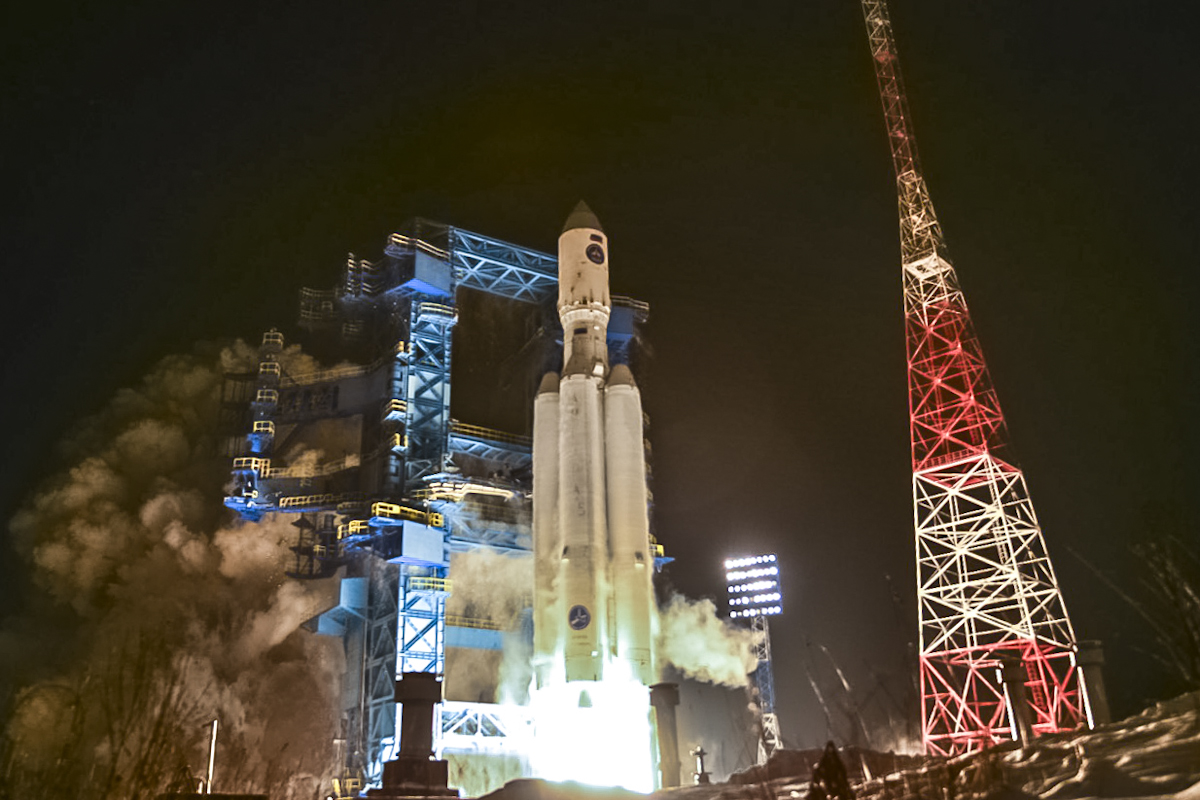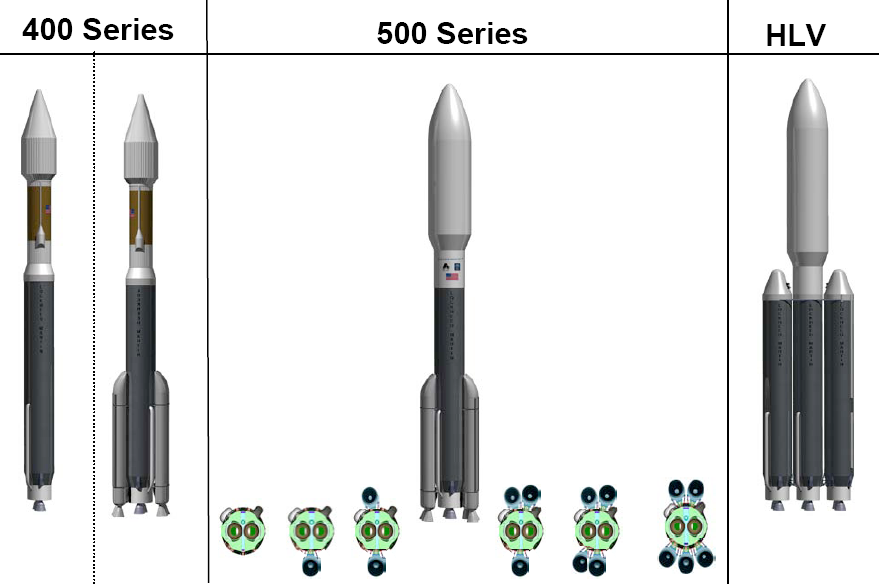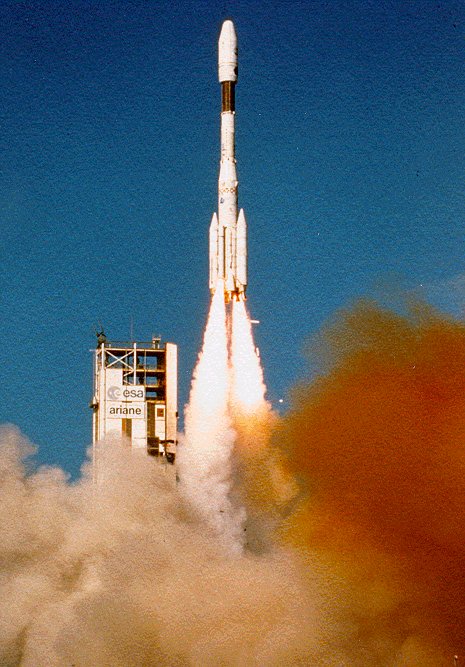|
Universal Rocket Module
Universal Rocket Module (URM) is the name of the modular liquid fuelled first and second stage of the Angara expendable launch system. The first stage and booster variant is referred to as URM-1, while the second stage is referred to as URM-2. The URM-2 is derived from the Soyuz-2 Block I second stage. URM-1 is a unitary structure 2.9 meters in diameter and 25 meters in length that includes an oxidizer tank, a fuel tank (both tanks being coupled by a spacer) and an RD-191 engine burning RP-1 fuel with liquid oxygen producing a thrust of 1.92 MN. URM-1 was first flown in 2014 on the Angara 1.2PP suborbital test flight. Angara can fly with either one URM-1 in the case of Angara 1.2 and Angara 1.2PP, or one URM-1 as a sustainer core with four additional URM-1s as boosters for Angara A5. URM-2 is a modified Block I stage, 3.6 meters in diameter and 6.9 meters in length. It is powered by a single RD-0124A producing 294 kilonewtons, derived from Block I's RD-0124. URM-2 was fir ... [...More Info...] [...Related Items...] OR: [Wikipedia] [Google] [Baidu] |
Khrunichev State Research And Production Space Center
The Khrunichev State Research and Production Space Center (''Государственный космический научно-производственный центр (ГКНПЦ) имени М. В. Хру́ничева'' in Russian) is a Moscow-based manufacturer of spacecraft and space-launch systems, including the Proton and Rokot rockets, and the Russian modules of Mir and the International Space Station. The company's history dates back to 1916, when an automobile factory was established at Fili, western suburb of Moscow. It soon switched production to airplanes and during World War II produced Ilyushin Il-4 and Tupolev Tu-2 bombers. A design bureau, OKB-23, was added to the company in 1951. In 1959, the company started developing intercontinental ballistic missiles, and later spacecraft and space launch vehicles. The company designed and produced all Soviet space stations, including Mir. OKB-23, renamed to ''Salyut Design Bureau'', became an independent company ... [...More Info...] [...Related Items...] OR: [Wikipedia] [Google] [Baidu] |
Angara A5
The Angara rocket family (Russian: Ангара) is a family of launch vehicles being developed by the Moscow-based Khrunichev State Research and Production Space Center. The launch vehicles are to put between and into low Earth orbit and are intended, along with Soyuz-2 variants, to replace several existing launch vehicles. History After the dissolution of the Soviet Union, many formerly Soviet launch vehicles were built in or required components from companies now located in Ukraine, such as Yuzhnoye Design Bureau, which produced Zenit-2, and Yuzhmash, which produced Dnepr and Tsyklon. Additionally, the Soviet Union's main spaceport, Baikonur Cosmodrome, was located in Kazakhstan, and Russia encountered difficulties negotiating for its use. This led to the decision in 1992 to develop a new entirely Russian launch vehicle, named Angara, to replace the launch vehicles now built outside of the country, and ensure Russian access to space without Baikonur. It was decided that ... [...More Info...] [...Related Items...] OR: [Wikipedia] [Google] [Baidu] |
Delta IV
Delta IV is a group of five expendable launch systems in the Delta (rocket family), Delta rocket family introduced in the early 2000s. Originally designed by Boeing's Defense, Space and Security division for the National Security Space Launch, Evolved Expendable Launch Vehicle (EELV) program, the Delta IV became a United Launch Alliance (ULA) product in 2006. The Delta IV is primarily a launch vehicle for United States Air Force (USAF) military payloads, but has also been used to launch a number of United States government non-military payloads and a single commercial satellite. The Delta IV originally had two main versions which allowed the family to cover a range of payload sizes and masses: the retired Medium (which had four configurations) and Delta IV Heavy, Heavy. As of 2019, only the Heavy remains active, with payloads that would previously fly on Medium moving to either the existing Atlas V or the forthcoming Vulcan (rocket), Vulcan. Retirement of the Delta IV is antici ... [...More Info...] [...Related Items...] OR: [Wikipedia] [Google] [Baidu] |
Common Booster Core
The Common Booster Core (CBC) is an American rocket stage, which is used on the Delta IV rocket as part of a modular rocket system. Delta IV rockets flying in the retired Medium and Medium+ configurations each used a single Common Booster Core as their first stage, while the Heavy configuration uses three; one as the first stage and two as boosters. The Common Booster Core is long, has a diameter of and is powered by a single RS-68 engine burning liquid hydrogen and liquid oxygen. The first static test-firing of a Common Booster Core was conducted on 17 March 2001, and the final test of the initial program was conducted on 6 May. Testing was conducted using Test Stand B-2 of the Stennis Space Center, a facility originally constructed for testing of the first stages of Saturn V rockets during the 1960s. The first launch of a Common Booster Core was the maiden flight of the Delta IV, which was launched from Space Launch Complex 37B at the Cape Canaveral Space Force Station on ... [...More Info...] [...Related Items...] OR: [Wikipedia] [Google] [Baidu] |
Atlas V
Atlas V is an expendable launch system and the fifth major version in the Atlas (rocket family), Atlas launch vehicle family. It was originally designed by Lockheed Martin, now being operated by United Launch Alliance (ULA), a joint venture between Lockheed Martin and Boeing. Atlas V is also a major NASA launch vehicle. It is America's longest-serving active rocket. In August 2021, ULA announced that Atlas V would be retired, and all 29 remaining launches had been sold. , 19 launches remain. Each Atlas V launch vehicle consists of two main stages. The first stage (rocketry), first stage is powered by a Russian RD-180 engine manufactured by NPO Energomash, Energomash and burning kerosene and liquid oxygen. The Centaur (rocket stage), Centaur upper stage is powered by one or two American RL10 engine(s) manufactured by Aerojet Rocketdyne and burns liquid hydrogen and liquid oxygen. The Star 48 upper stage was used on the ''New Horizons'' mission as a third stage. strap-on booster, ... [...More Info...] [...Related Items...] OR: [Wikipedia] [Google] [Baidu] |
Common Core Booster
The Common Core Booster (CCB) is an American rocket stage, which is used as the first stage of the Atlas V rocket as part of its modular design. It was also intended that two additional CCBs would be used as boosters on the Atlas V Heavy, however this configuration has not been developed. Use of a Common Core Booster as the first stage of the Japanese GX was also planned; however, this program was cancelled in late 2009. The Common Core Booster is long, has a diameter of and is powered by a single RD-180 engine burning RP-1 and liquid oxygen. Testing of the CCB and its RD-180 engines was conducted in the United States at the Marshall Space Flight Center, and in Khimki, Russia. The test programme concluded with the final engine test in December 2001. The first launch of a Common Core Booster was the maiden flight of the Atlas V, which was launched from Space Launch Complex 41 at the Cape Canaveral Air Force Station on 21 August 2002. As of November 2020, the Atlas V has made ... [...More Info...] [...Related Items...] OR: [Wikipedia] [Google] [Baidu] |
Liquid Rocket Booster
A liquid rocket booster (LRB) uses liquid fuel and oxidizer to give a liquid-propellant or hybrid rocket an extra boost at take-off, and/or increase the total payload that can be carried. It is attached to the side of a rocket. Unlike solid rocket boosters, LRBs can be throttled down if the engines are designed to allow it, and can be shut down safely in an emergency for additional escape options in human spaceflight. History By 1926, US scientist Robert Goddard had constructed and successfully tested the first rocket using liquid fuel at Auburn, Massachusetts. For the Cold War era R-7 Semyorka missile, which later evolved into the Soyuz rocket, this concept was chosen because it allowed all of its many rocket engines to be ignited and checked for function while on the launch pad. The Soviet Energia rocket of the 1980s used four Zenit liquid fueled boosters to loft both the '' Buran'' and the experimental '' Polyus'' space battlestation in two separate launches. Two versions ... [...More Info...] [...Related Items...] OR: [Wikipedia] [Google] [Baidu] |
Universal Rocket
The Universal Rocket or ''UR'' family of missiles and carrier rockets is a Russian, previously Soviet rocket family. Intended to allow the same technology to be used in all Soviet rockets, the UR is produced by the Khrunichev State Research and Production Space Center. Several variants were originally planned, of which only three flew, and only two of which entered service. In addition, the cancelled UR-500 ICBM formed the basis for the Proton carrier rocket. UR-100 The UR-100 and its variants (e.g. UR-100N) were the standard small ICBM of the Soviet Union during the Cold War. Only the UR-100N (NATO reporting designation: SS-19 Stiletto) remains in active duty, with 20–30 missiles operational. The Strela and Rokot carrier rockets are based on the UR-100N. A number of UR-100Ns have been earmarked for use as launch vehicles for the Avangard maneuverable reentry vehicle. UR-200 The UR-200 was intended to be a larger ICBM that could also be used as a carrier rocket. Nine tes ... [...More Info...] [...Related Items...] OR: [Wikipedia] [Google] [Baidu] |
Korea Aerospace Research Institute
The Korea Aerospace Research Institute (KARI), established in 1989, is the aeronautics and space agency of South Korea. Its main laboratories are located in Daejeon, in the Daedeok Science Town. KARI's vision is to continue building upon indigenous launch capabilities, strengthen national safety and public service, industrialize satellite information and applications technology, explore the moon, and develop environmentally-friendly and highly-efficient cutting-edge aircraft and core aerospace technology. Current projects include the KSLV-2 launcher. Past projects include the 1999 Arirang-1 satellite. The agency was founded in 1989. Prior to South Korea's entry into the Institute for Advanced Engineering (IAE) in 1992, it focused primarily on aerospace technology. Background KARI began on October 10, 1989, as a national aerospace research institute with the purpose of contributing to sound development of the national economy and enhancement of people's lives through a ... [...More Info...] [...Related Items...] OR: [Wikipedia] [Google] [Baidu] |
South Korea
South Korea, officially the Republic of Korea (ROK), is a country in East Asia, constituting the southern part of the Korea, Korean Peninsula and sharing a Korean Demilitarized Zone, land border with North Korea. Its western border is formed by the Yellow Sea, while its eastern border is defined by the Sea of Japan. South Korea claims to be the sole legitimate government of the entire peninsula and List of islands of South Korea, adjacent islands. It has a Demographics of South Korea, population of 51.75 million, of which roughly half live in the Seoul Capital Area, the List of metropolitan areas by population, fourth most populous metropolitan area in the world. Other major cities include Incheon, Busan, and Daegu. The Korean Peninsula was inhabited as early as the Lower Paleolithic period. Its Gojoseon, first kingdom was noted in Chinese records in the early 7th century BCE. Following the unification of the Three Kingdoms of Korea into Unified Silla, Silla and Balhae in the ... [...More Info...] [...Related Items...] OR: [Wikipedia] [Google] [Baidu] |
Launch Vehicle
A launch vehicle or carrier rocket is a rocket designed to carry a payload (spacecraft or satellites) from the Earth's surface to outer space. Most launch vehicles operate from a launch pad, launch pads, supported by a missile launch control center, launch control center and systems such as vehicle assembly and fueling. Launch vehicles are engineered with advanced aerodynamics and technologies, which contribute to large operating costs. An orbital spaceflight, orbital launch vehicle must lift its payload at least to the boundary of space, approximately and accelerate it to a horizontal velocity of at least . Suborbital spaceflight, Suborbital vehicles launch their payloads to lower velocity or are launched at elevation angles greater than horizontal. Practical orbital launch vehicles are multistage rockets which use chemical propellants such as Solid-propellant rocket, solid fuel, liquid hydrogen, kerosene, liquid oxygen, or Hypergolic propellants. Launch vehicles are cla ... [...More Info...] [...Related Items...] OR: [Wikipedia] [Google] [Baidu] |
Naro-1
Naro-1 ( ko, 나로호), previously designated the Korea Space Launch Vehicle or KSLV (also KSLV-1), was South Korea's first carrier rocket, and the first South Korean launch vehicle to achieve Earth orbit. On January 30, 2013, the third Naro-1 vehicle built successfully placed STSAT-2C into low Earth orbit. The first stage was a modified Russian Angara URM. The solid-fuel second stage was built by KARI, the national space agency of South Korea, and Korean Air. Neither the maiden flight on August 25, 2009, nor the second flight on June 10, 2010, reached orbit. The third flight on January 30, 2013, successfully reached orbit. The launches took place from the Naro Space Center. The official name of the first KSLV rocket, KSLV-I, is Naro, which is the name of the region in which Naro Space Center is located. Since Naro's retirement, the South Korean government has announced the rocket Nuri as its replacement and successor. History In 1992, Republic of Korea developed and la ... [...More Info...] [...Related Items...] OR: [Wikipedia] [Google] [Baidu] |





_0472.jpg)
